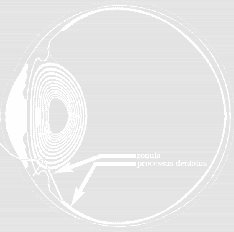by Dr Dan Waniek, MD
Copyright © 2006 danwaniek.org
The meaning of such differential stimulation of the processi dentati, according to an irido-morphologic code, could be to provide optical information to the cortex - with the purpose of producing specific signals of homeostatic value to targets within the body.
Should this model be true, a coherent possibility for a new homeostatic circle arises :
( a ) A deficient structure within the body might induce changes in iridial morphology
or...
( a' ) deficiencies might be expressed in the morphogenesis of the iris of the same phenotype.
( b ) The iris codes the light signal and transmits it to the ora serrata;
( c ) The ora serrata informs the cortex, acting like a peripheral sensitive homunculus,
(c') possibly via the lateral geniculate body and the pulvinar of the thalamus...
( c'' ) because of their strategic position in the diencephalon;
( d ) The cortex produces homeostatic messages ( nerve impulses or chemical mediators )...
( d' ) to compensate for the deficiency...
( d'' ) possibly by converting normal into “ exceptional ” metabolic pathways.
Understanding the Iris :
Non-visual functions of the Eye.
Trans-Iridial Studies Updates :
An Electronic Magazine
ISSN 1297-9953
Tuesday, April 11, 2006
Opus Princeps of Trans-Iridial Studies : Model
by Dr Dan Waniek, MD
Copyright © 2006 danwaniek.org
This anatomical entity could be a functional unit for non-visual processing of light information. It would provide homeostatic messages to the brain, not in the form of images, by physiological mechanisms that are still to be discovered.

Fig. 5 : Pathways of Light in Sagittal Sections of the Anterior Pole.
The optical information is hypothetically coded by the radial transparency pattern of the iris in terms of intensity, position and specific local absorption of the transmitted light, and is received by the corresponding dentate process.
Copyright © 2006 danwaniek.org
This anatomical entity could be a functional unit for non-visual processing of light information. It would provide homeostatic messages to the brain, not in the form of images, by physiological mechanisms that are still to be discovered.

Fig. 5 : Pathways of Light in Sagittal Sections of the Anterior Pole.
The optical information is hypothetically coded by the radial transparency pattern of the iris in terms of intensity, position and specific local absorption of the transmitted light, and is received by the corresponding dentate process.
Opus Princeps of Trans-Iridial Studies : More Data
by Dr Dan Waniek, MD
Copyright © 2006 danwaniek.org
The observation has been confirmed by many recent photographs taken from the interior of the eyeball, including this original indeed historical one :

Fig : 4 : High resolution intra-ocular photograph taken in vivo, from behind the lens and towards the anterior pole. Courtesy of Paris Match © Lennart Nilssen, 1985, by kind permission.
Copyright © 2006 danwaniek.org
The observation has been confirmed by many recent photographs taken from the interior of the eyeball, including this original indeed historical one :

Fig : 4 : High resolution intra-ocular photograph taken in vivo, from behind the lens and towards the anterior pole. Courtesy of Paris Match © Lennart Nilssen, 1985, by kind permission.
Subscribe to:
Comments (Atom)